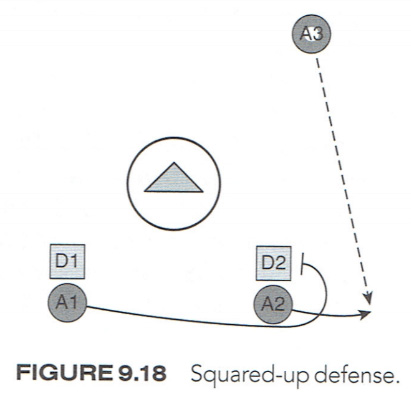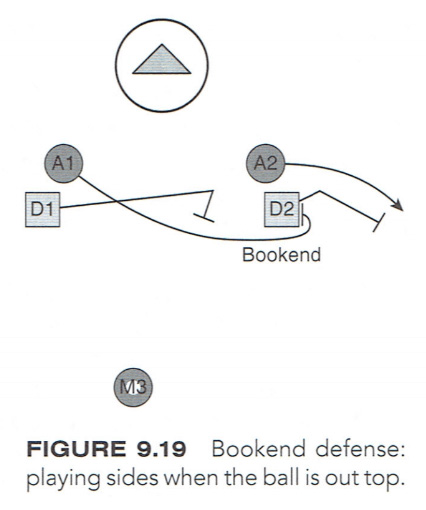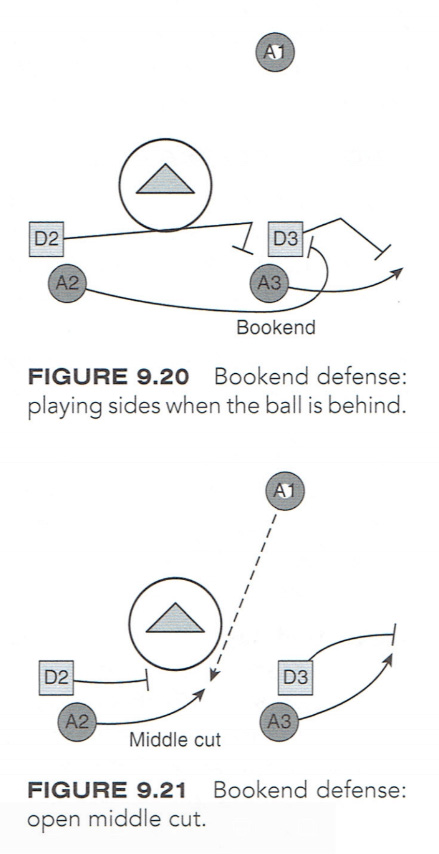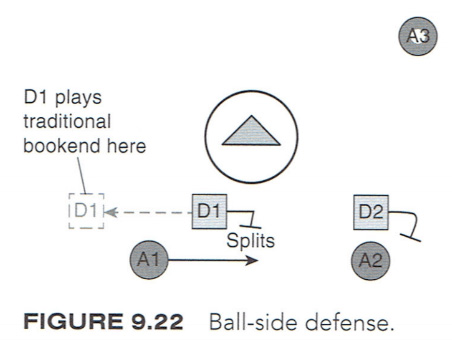| Defense - Two Man Picks Inside |
| By: Don Zimmerman and Peter England
Originally Published in: Men's Lacrosse Provided by: Human Kinetics The general rule inside is that you should defend your opponent topside. Also, when defending inside (from the crease to 10 yards out), you can't afford to have a cushion. The inside crease area is the most dangerous area of the field because attackers are so close to the goal. If the offense gets the ball in their stick inside, they are dangerous immediately. If you give your opponents a cushion through a pick, they could pop out for a spot feed and quick shot. Defenders have to automatically switch inside because it's just too difficult for a defender to stay with his man and play man-to-man inside. If your man separates from you or you give him a cushion to maneuver inside, you have to close that distance immediately. You must close the gap, anticipating the check call from the goalie, and must have your stick ready to check down. The defensive strategies against two-man picks inside include playing squared up, bookend, or ball side. Squared Up In this strategy, defenders play squared up on their men on the crease (see figure 9.18). Both defenders are vulnerable to being sealed off by a pick on their outside shoulder, and the attackers can pop out for a quick shot. For example, let's assume that attacker 3 has the ball behind the goal. Attacker 2 is on the crease and is being played by defender 2. Attacker 1 is on the crease and is being played by defender 1. Attacker 1 sets a pick on the outside shoulder of defender 2, and attacker 2 cuts off the pick toward the wing area. It's difficult for defender 2 to fight through the pick and cover attacker 2 on the cut, and both defenders get "backed up" on the crease.
Bookend In the bookend strategy, both defenders position themselves on the outside shoulders of their opponent. Each defender positions himself so that the opponent can't get to his outside shoulder to set a pick. Both defenders play sides (two-man zone) on the crease and are ready to switch on picks. For example, let's assume that midfielder 3 has the ball out top, as shown in figure 9.19.
Attacker 1 and attacker 2 are both on the crease; defender 1 and defender 2 play bookends or sides. Attacker 1 sets a pick on defender 2, and attacker 2 cuts behind the pick and curls out, looking for a feed from midfielder 3 out top. Defender 1 switches and covers attacker 2 on the cut. Defender 1 and defender 2 are expecting something coming back the other way, so they are playing sides and are ready to switch. In another example, as shown in figure 9.20, attacker 1 has the ball behind the goal. At-tacker 2 and attacker 3 are both on the crease; defender 2 and defender 3 play bookends or sides. Attacker 2 sets a pick on defender 3, and attacker 3 cuts behind the pick and curls out, looking for a feed from attacker 1 behind the goal. Defender 2 switches and covers attacker 3 on the cut. The main weakness is that the two defenders can't satisfactorily cover a middle cut.
In a third example, attacker 1 again has the ball behind the goal. Defender 2 and defender 3 bookend attacker 2 and attacker 3 on the crease. Attacker 2 drives toward attacker 1, and defender 2 covers attacker 2. Because defender 2 is bookending attacker 2, attacker 2 can cut through the middle and has an unobstructed path to the ball (see figure 9.21). Ball Side In this strategy, the ball-side defender plays on the outside shoulder of his man, and the off-ball defender plays topside on his man. For example, let's assume that attacker 3 has the ball behind the goal. Defender 1 and defender 2 play ball side versus attacker 1 and attacker 2 on the crease. Attacker 1 carries the ball toward defender 2 and defender 2 gets to the outside shoulder on the ball side of attacker 2. Defender 1 splits attacker 1 and attacker 2, and he plays more ball side (topside) on attacker 1 (not bookend). Defender 1 and defender 2 stay relative to one another. Defender 1 and defender 2 overplay ballside (not bookend), and they don't allow a gap to occur between them where attacker 1 could cut to the ball in the gap (see figure 9.22).
|










